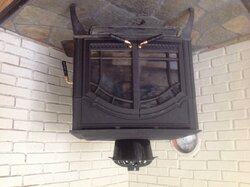Hi! New to this forum. After freezing my polar vortex off this winter in Connecticut and going to my daughter and son-in-law's warm, wood burning home every once in a while to thaw out, I took the leap and bought a used, mint condition Quadra Fire Cumberland Gap free standing wood stove (see attached pic) I have an existing clay lined chimney in excellent condition in my family room that the previous owner installed for a wood stove, but never used, and last year I had a new chimney cap installed when they were here sweeping my fireplace in my living room. So now I just need to install a SS liner (thanks to all on this forum.....I've been hovering over this site all winter). It will be a rear vent and then straight up about 15 ft (guessing). My question is, I had an installer come that I believe is top notch. He gave me a price of $1,350.00. I just want to see if this is a fair price. Being a woman, I'm about as comfortable with this as I am shopping for car tires.  seeing as this is an existing chimney with a straight shot up and existing new cap, just wondering if this price is reasonable. BTW, I live in Guilford, CT, if that helps with the pricing. Thanks for any advice as I am Clueless In Connecticut!!
seeing as this is an existing chimney with a straight shot up and existing new cap, just wondering if this price is reasonable. BTW, I live in Guilford, CT, if that helps with the pricing. Thanks for any advice as I am Clueless In Connecticut!!
 seeing as this is an existing chimney with a straight shot up and existing new cap, just wondering if this price is reasonable. BTW, I live in Guilford, CT, if that helps with the pricing. Thanks for any advice as I am Clueless In Connecticut!!
seeing as this is an existing chimney with a straight shot up and existing new cap, just wondering if this price is reasonable. BTW, I live in Guilford, CT, if that helps with the pricing. Thanks for any advice as I am Clueless In Connecticut!!


 !
!